
VĂN HÓA https://jst-haui.vn Tạp chí Khoa học và Công nghệ Trường Đại học Công nghiệp Hà Nội Tập 60 - Số 10 (10/2024)
68
NGÔN NG
Ữ
P
-
ISSN 1859
-
3585
E
-
ISSN 2615
-
961
9
SMARTCLASS
SOFTWARE
DESIGN
AND
ITS
IMPACTS ON
LEARNING
IN
INTERPRETING
CLASSES:
STUDENTS'
PERCEPTIONS
PHẦN MỀM SMARTCLASS VÀ TÁC ĐỘNG ĐỐI VỚI QUÁ TRÌNH HỌC TRONG CÁC LỚP HỌC PHIÊN DỊCH: QUAN ĐIỂM CỦA SINH VIÊN Lâm Thị Lan Hương1, Nguyễn Thị Minh Thảo2,*, Nguyễn Thị Vân Khánh2 DOI: http://doi.org/10.57001/huih5804.2024.326 ABSTRACT Computer Assisted Language Learning (CALL) is not a trend; it has become practice in various contexts of language teaching an
d learning. However, CALL
practices these days do not isolate the use of
computers from the internet and various educational software and applications. This paper is to explore student
perceptions on Smartclass software (SCS) design and its impacts on learning in interpreting classes of English and Korean major students
at a university in
Vietnam. Then a comparison between student perceptions of these two majors was also recorded. Data were collected from (1) survey qu
estionnaires with 52
English major students and 47 Korean major ones who firstly used SCS in their basic interpreting course; and (
2) three focus group interviews with 18 students,
9 from each major. The findings revealed students’ overall positive evaluation of SCS design and its impacts on learning in i
nterpreting classes. However, different
perceptions of English and Korean major s
tudents were discussed about SCS in terms of its design and impacts on learning in interpreting classes. Pedagogical
implications were also suggested. Keywords: Smartclass software; perceptions; software design; impacts; interpreting. TÓM TẮT Việc sử dụng máy tính trong dạy học ngoại ngữ (CALL) đã phát triển từ một xu hướng trở thành một hoạt động quan trọng với nhiều bối cảnh giảng dạ
y và
học tập ngôn ngữ khác nhau. Các phương pháp dạy học với CALL hiện đại không chỉ dừng lại ở việc sử dụng máy tính mà còn tích hợp internet, các ứng dụ
ng và
phần mềm giáo dục khác nhau để nâng cao việc học tập của người học. Nghiên cứu này là để tìm hiểu đánh giá của sinh viên về thiết kế của phần mề
m Smartclass
(SCS) và tác động của phần mềm này đến việc học trong các khóa học phiên dịch của cho sinh viên ngành ngôn ngữ Anh và ngôn ngữ Hàn Quốc tại một trườ
ng
đại học Việt Nam. Nhóm tác giả cũng tiến hành phân tích, so sánh về quan điểm của sinh viên của hai nhóm ngành này. Dữ liệu được thu thập thông qua (1) bả
ng
khảo sát dành cho 52 sinh viên ngành ngôn ngữ Anh và 47 sinh viên ngành ngôn ngữ Hàn Quốc trong kỳ học phiên dịch cơ bản với phần mềm SCS; và (2) ba buổ
i
phỏng vấn nhóm với 18 sinh viên, mỗi ngành 9 sinh viên. Kết quả chỉ ra rằng, sinh viên có đánh giá tích cực về thiết kế của SCS và tác động của nó đến việc họ
c.
Tuy nhiên, có sự khác biệt đáng kể trong quan điểm của sinh viên ngành ngôn ngữ Anh và sinh viên ngành ngôn ngữ Hàn Quốc về thiết kế phần mề
m SCS và tác
động của nó đến việc học trong các lớp phiên dịch. Nghiên cứu cũng đưa ra những đề xuất mang tính sư phạm. Từ khóa: Phần mềm Smartclass, quan điểm, thiết kế phần mềm, ảnh hưởng, phiên dịch. 1ThuyLoi University, Vietnam 2School of Languages and Tourism, Hanoi University of Industry, Vietnam *Email: thaontm@haui.edu.vn Received: 10/9/2024 Revised: 21/10/2024 Accepted: 28/10/2024

P-ISSN 1859-3585 E-ISSN 2615-9619 https://jst-haui.vn LANGUAGE - CULTURE Vol. 60 - No. 10 (Oct 2024) HaUI Journal of Science and Technology
69
1. INTRODUCTION The swift advancement of technology and the widespread integration of technological innovations across various sectors of society are closely associated with continuous innovation, process enhancement, and resource optimization [1]. The ongoing development and integration of technologies present a significant challenge for educators and educational institutions. The teaching-learning process demands constant adaptation, necessitating the continuous evolution as well as a transformation in teaching and learning approaches in order to meet needs and profiles of learners who are deeply engaged in a digital environment and influenced by the imperatives of sustainable development [2, 3]. Learner-Z situation, teachers should talk less and students should do more discovering. This approach can be done in a digital environment, students are more engaged and active in their learning [4]. Meanwhile, there has been vivid interest in incorporating smart classroom technology and digital tools, especially specialized software to create more interactive and engaging learning environments while improving educational results [5, 6]. Smartclass Software (SCS) has been deployed in interpreting courses in School of Languages and Tourism (SLT), Hanoi University of Industry (HaUI) since 2015 with English Language. Gradually, other Faculties of Languages in SLT including Faculty of Chinese Language, Faculty of Japanese Language, Faculty of Korean Language also utilized SCS in their interpreting training courses. In addition, basic interpreting is the first course in the sequential interpretation training with SCS for language-majored students at SLT. However, this course accounts for 4 credits in English linguistics while 3 credits in Korean linguistics. The software showed its effectiveness in interpreter training thanks to an increase in students’ quality of consecutive interpreting [7]. Together with smart classroom devices, the SCS helped English major students improve their engagement, autonomy, and interaction in interpreting classes [8]. However, there has been little research on comparing the impacts of SCS design itself on students’ learning in interpreting classes of different languages at SLT, HaUI. The authors would like to explore students’ evaluation on SCS design and its impacts on their learning in interpreting classes of English and Korean languages, then find out if there are any differences in SCS design and its impacts perceived by these two groups of students. Hence, the study aims to address the following research questions: 1. How do English major students and Korean major students evaluate SCS in terms of its design and impact on their learning in interpreting classes? 2. What are the differences in SCS design and its impacts perceived by English major students and Korean major students? 2. LITERATURE REVIEW 2.1. CALL in education The concept of CALL is not unfamiliar with many educators, lecturers and even learners. In fact, the application of technology in general and CALL in particular has changed significantly and positively in the education sector [9]. According to Pazilah et al. [10], the digital environment enhances learners' motivation and interest, leading to improved performance in their learning. This was also emphasized in a study by Phoong et al. [11], stating that the interactive environment created in CALL enhances learners’ interest and involvement in class activities. One important factor to make CALL effective is CALL software. More importantly, teachers’ literacy of using computers, technical devices and software is always appreciated in CALL as Bradin [12] notes, “language teachers who are not accustomed to looking at CALL software may perceive its purpose very differently than those who are more experienced” (p. 159). Computer-equipped classrooms with internet-connected devices, teaching management software, and interaction-supporting systems, have been considered as smart classrooms, would increase students’ engagement, motivation and excitement about learning, according to MacLeod et al. [13] and Li et al. [14]. Therefore, smart classrooms should be assessed in some aspects including its design, ease of use and multiple sources, learning motivation, interaction and learners’ autonomy. 2.2. Software design and learning factors Shehneela [15] stated that in EFL classrooms, multimedia tools have been shown to improve student interaction and participation, with positive student attitudes towards multimedia-enhanced lectures. Similarly, specialized software can create more interactive and engaging learning environments, leading to higher educational results [5, 6]. Wu [16] has developed a classroom with the Rain Classroom application, allowing students to learn interpretation inside and outside the classroom. Students enjoyed this class as they

VĂN HÓA https://jst-haui.vn Tạp chí Khoa học và Công nghệ Trường Đại học Công nghiệp Hà Nội Tập 60 - Số 10 (10/2024)
70
NGÔN NG
Ữ
P
-
ISSN 1859
-
3585
E
-
ISSN 2615
-
961
9
could personalize their learning through various pre-designed materials. This classroom also allows students to interact effectively with assistive technology devices, thereby increasing the effectiveness of face-to-face learning with teachers. 2.3. Smartclass software SCS is developed by Robotel Inc. in Canada. In Vietnam, SCS is provided by Sao Mai Education Group, the Robotel’s representative in Vietnam. Two applications available for teachers are SC Hub and SC Live. Accordingly, SC Hub provides a digital platform with language labs and structured courses. It supports multi-user interaction and allows teachers to manage students’ learning process with diverse activities for practicing all language skills. Materials could be pictures, text, pdf files, audio, video, and web links. Students can listen, read, write and record their speaking within pre-set time windows. Teachers can assign a flexible blend of classroom and self-access activities. All students can practice simultaneously. Meanwhile, SC Live can be a powerful tool for teachers to monitor class activities. This application allows teachers to run class activities from their computer and watch students’ screens on each computer and manage students’ progress as they are doing digital interpreting assignments in class. SC Live helps teachers provide assistance to individual students, focus student attention and prevents students from off-the-track activities like texting and web surfing. In the study by Nguyen et al. [8], the SCS is user-friendly, allowing students to learn to use it quickly, keep track of their progress, be free to choose which tasks to complete, and receive feedback from teachers. However, in that specific study of the smart classroom context, there is no clear evidence that the software itself could influence learners in the same way as the whole smart classrooms (consisting of computers, the software, internet connection, and interaction-supporting systems), or that there could be different impacts between language majors. Therefore, this study would aim to add on those elements by finding out answers for the research questions. 3. RESEARCH METHODOLOGY 3.1. Research Site and Participants This study was conducted at SLT, HaUI where the SCS has been invested to serve interpretation training for students majoring in English, Chinese, Korean, and Japanese languages. Among the four language majors, English Language was the first to be established and also the first major at the institution to utilize SCS, in 2015. The Korean language major was established the latest with the first usage of SCS in 2021. English language teachers who are responsible for interpretation subjects received direct training from Sao Mai Education Group. Meanwhile, teachers of the other three language majors were subsequently trained and supported by English language teachers through internal training sessions. Therefore, the authors aimed to explore the perceptions of students from English Language and Korean Language toward the design of SCS and its impacts in their interpreting classes. The authors also want to find out any differences in the student perceptions of the two majors. A total of 54 junior English major students (2 classes) and 52 junior Korean major students (2 classes) were asked to answer an online questionnaire. However, the recorded responses were 52 and 47 respectively. The researchers also conducted in-depth interviews with three groups of students from these two majors. 3.2. Research Instruments and Procedure The authors employed a mixed research method with a survey questionnaire and semi-structured focus group interviews. The questionnaire was adapted from studies by Li et al. [14] and MacLeod et al. [13]. There are 24 questions in the questionnaire (see Appendix A) including 22 close-ended questions (SCS design - 6 items; learning motivation - 5 items; learners' autonomy - 5 items; learning interaction - 6 items) and two open-ended questions. Student respondents claimed their perspectives by giving a tick on a five-point Likert scale for each item. The reliability of the questionnaire is evaluated with the collected data. The instrument’s Cronbach's Alpha is 0.961, greater than 0.80, confirming its trustworthiness. After checking the reliability of questions in themes, question 2.9 is not reliable, so the question is deleted when calculating factors related to motivation. To gain the students’ opinions on the usage of SCS in interpreting classes, three focus group interviews (see Appendix B) were carried out with open-ended questions and lasted approximately 30 minutes each. There are 6 students (3 English major students and 3 Korean major ones) in an interview. The answers in interviews helped the researchers deeper understand what are student perceptions; how and why students have different viewpoints on SCS design and its impacts on learning in interpreting classes. 3.3. Data Processing and Analysis The quantitative data collection process employed Google Forms for administering the survey questionnaire

P-ISSN 1859-3585 E-ISSN 2615-9619 https://jst-haui.vn LANGUAGE - CULTURE Vol. 60 - No. 10 (Oct 2024) HaUI Journal of Science and Technology
71
and Excel for data coding. The collected data was analysed with SPSS version 20.0, utilizing descriptive statistics to evaluate the findings. The respondents who answered in the third part of the questionnaire are chosen for interviews. The researchers recorded audio files with additional detailed notes during the semi-structured interviews to collect qualitative data. The audio recordings were then transcribed by a soundscriber program, and the interview transcripts were shared with the interviewees for their revision and confirmation. Key themes and subcategories, along with phrases and terms were identified and grouped. Focus group interviews were labelled from FGI1 to FGI3. Student informants in each FGI were described S1 to S6 (English-major students were S1, S2, S3 while Korean-major students were S4, S5, S6). The final findings were synthesized and analyzed by comparing and contrasting data from both the survey questionnaires and three focus group interviews. 4. FINDINGS AND DISCUSSION In this section, the authors focused on illustrating and discussing the results collected from questionnaires and interviews, thereby finding answers to the research questions. Research question 1: How do English and Korean major students evaluate SCS in terms of its design and impact on their learning in interpreting classes? The authors presented students’ evaluation of SCS in terms of its design and impacts in increasing students’ motivation, interaction and autonomy. SCS design Table 1. Students’ evaluation of the SCS design Items When using SCS, I can … Mean
Std. Deviation
Q2.6 access to various sources of learning materials such as pictures, pdf, audios and videos 4.22 0.78 Q2.4 explain and discuss my ideas with teachers and other students. 4.04 1.02 Q2.1 take a short time to learn how to use it. 3.92 0.84 Q2.3 quickly receive tasks from the teacher and submit my assignments. 3.90 1.01 Q2.5 flexibly choose learning tasks to complete. 3.77 0.98 Q2.2 easily store my learning progress. 3.74 0.92 Table 1 presents data collected from student survey questionnaires on their perceptions of various aspects of SCS design. It can be seen clearly that the highest-rated aspect was getting access to various sources of learning materials in various modes (picture, text, audios, or/and videos) scoring 4.22, reflecting the high value students placed on multimodality of materials. Ranging from 3.74 to 4.04, other aspects of software design are perceived as moderate ease of use, flexibility in task selection, tracking of students’ progress, and support for discussion with teachers and peers. The focus group interview helped the searchers understand why student respondents are interested in using SCS in their learning at interpreting classes. Almost of informant agreed that it took them not much time to work with the SCS. While FGI1S2 affirmed “I watched a given video on how to use this SCS and I could operate nearly all the tasks smoothly right at the first day at the smart classroom”, FGI1S6 added “Learning how to use SCS is actually not a problem for me”. It can be said that SCS design is quite effective and easy to use. It hopefully enhances students’ interest in learning interpreting, increasing their willingness in engaging in class activities as well as their self-study. Motivation Table 2. Students’ evaluation of SCS’s impacts on their motivation Items When using SCS, I can … Mean
Std. Deviation
Q2.11 be active with the student-centered classroom. 4.06 0.79 Q2.7 access a variety of fascinating topics and inspiring contents. 3.93 0.90 Q2.10 be allowed to interpret many times and choose the best version of interpreting. 3.93 0.77 Q2.8 acquire knowledge from different cultures. 3.66 0.96 Q2.9 freely explore resources related to my favourable topics on the Internet. 1 .82 0.72 The related figures in Table 2 show that the working of SCS alone would fail to help students explore the Internet, and this is a must because the SCS is also operated for assessment activities, in addition to other learning practices. It is the internet-connected computer installed with SCS allows students to do so. This explains why Nguyen et al. [8] got high agreement among participants as they took the whole smart classroom into consideration. By interviewing, further qualitative data on student perceptions on impacts of SCS design on student motivation was unveiled.

VĂN HÓA https://jst-haui.vn Tạp chí Khoa học và Công nghệ Trường Đại học Công nghiệp Hà Nội Tập 60 - Số 10 (10/2024)
72
NGÔN NG
Ữ
P
-
ISSN 1859
-
3585
E
-
ISSN 2615
-
961
9
“What motivated me most is that I could do my own interpreting at the same time with my peers, and then all of our interpreting versions would be submitted automatically and chosen randomly by my teacher for commenting and correcting.” FGI3S2 “I found using SCS in interpreting useful and exciting. I felt like I was a real interpreter, doing my real profession. I wished I had practiced interpreting skills with SCS in all my interpreting lessons”. FGI3S4 It is clear that SCS design motivated students in learning at interpreting class, increasing their engagement and willingness in class activities. Autonomy Table 3. Students’ evaluation of SCS’s impacts on their autonomy Items When using SCS, I can … Mean
Std. Deviation
Q2.12 be more self-conscious and have autonomous thinking with my own study. 4.29 0.76 Q2.15 store my learning history to review whenever I want to. 3.88 0.92 Q2.16 use resources and materials which are already available in the applications to self-practice. 3.78 0.94 Q2.14 deeply reflect on my interpreting progress. 3.71 0.97 Q2.13 have my own space to study independently.
3.63 0.99 In general, the SCS allows autonomous or individual learning, indicated by “Means” indicators ranging from 3.63 to 4.29, according to Table 3. The results from the interviews unveiled further information for students’ self-study. Some Korean major participants agreed that learning at SCS helped them to realize their mistake and correct it (FGI3S5; FGI2S4 and FGI1S4). Almost all English major informants show their interest in learning interpreting with teachers and peers via SCS. “I could learn by myself after my teacher and my peers gave comments on my interpreting versions, and corrected some mistakes for the second or another recording”. FGI2S1. This was shared by FGI2S3, FGI3S3 and FGI1S1. It can be concluded that students can improve their autonomy as well as their interpreting skills improvement thanks to various class activities via SCS. Table 4 shows that all 6 questions got “Mean” scores in the range of “agree” (from 3.41 to 4.2) in the 5-point Likert scale. This indicates that SCS can be a great tool for teachers to increase teacher-student and student-student interaction. Through the interviews, teaching methods were reflected. Some English major respondents revealed that individual works, pair works and group works given by teachers interested them. “My teacher sometimes changed my position to the next partner, so I could listen and give assessments and comments on his/her work” - FGI2S5. Interaction Table 4. Students’ evaluation of SCS’s impacts on their interaction Items When using SCS, I can … Mean
Std. Deviation
Q2.21 acquire various information from teachers and other students. 3.79 0.94 Q2.18 discuss my ideas with teachers and other students. 3.67 0.83 Q2.22 feel that teachers and students care about each other. 3.66 0.93 Q2.19 receive peer feedback and teachers’ assessment. 3.65 0.87 Q2.17 have an interactive environment that can boost my interest and involvement. 3.63 0.91 Q2.20 cooperate with other students when doing interpreting tasks in pairs or in groups. 3.55 1.00 Research question 2: What are the differences in SCS design and its impacts perceived by English major students and Korean major students? As discussed in Research question 1 there are different figures from the survey questionnaire. However, the “Means” indicators could stay in a certain range that defines the same level of perceptions. Therefore, the “Means” indicators are analysed in SPSS to investigate the significant differences between the two language majors, who work with the same software, in the same classrooms. According to Table 5, The “Mean” of SCS design of English students is 4.21 while that of Korean peers is 3.62. This shows that English students are satisfied with the SCS design. P value or the Sig. (2 tailed) smaller than 0.05 confirms that there is a statistically significant difference between the 2 groups of students’ perceptions of SCS design. The accompanied interviews unveiled the causes for the differences. While FGI2S1, FGI1S3 and FGI3S1 shared their points that SCS design is user-friendly and convenient for them to submit their interpreting tasks, FGI1S4 stated “My teacher sometimes asked us to record our interpreting versions via our mobile phones instead of SCS, so I did not store all of my interpreting assignments on

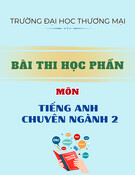
![Đề cương học phần Ứng dụng công nghệ thông tin trong giảng dạy ngoại ngữ (Application of Information Technology in Language Teaching) [Mới nhất]](https://cdn.tailieu.vn/images/document/thumbnail/2025/20250212/tuetuebinhan666/135x160/881739332468.jpg)

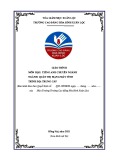


![Tài liệu giảng dạy Tiếng Anh chuyên ngành Thiết kế đồ họa (English for Graphic Design) - Trường CĐ Công nghệ TP.HCM [Mới nhất]](https://cdn.tailieu.vn/images/document/thumbnail/2024/20240830/xuanphongdacy04/135x160/61882549.jpg)
![Tài liệu giảng dạy Tiếng Anh chuyên ngành Công nghệ thông tin & Thiết kế đồ họa - Trường Cao đẳng Công nghệ TP.HCM [Mới nhất]](https://cdn.tailieu.vn/images/document/thumbnail/2024/20240830/xuanphongdacy04/135x160/4881725033257.jpg)
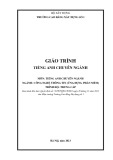
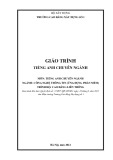

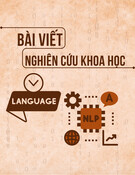
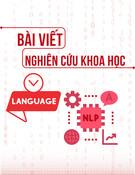
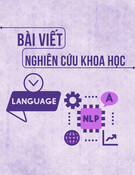
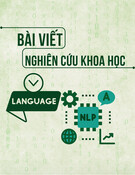
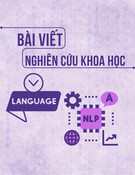
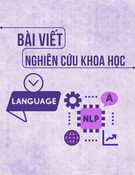

![Tài liệu Ngữ pháp HSK 3 [chuẩn nhất/ đầy đủ/ chi tiết]](https://cdn.tailieu.vn/images/document/thumbnail/2025/20251108/yenlethingoc49@gmail.com/135x160/11711762589284.jpg)
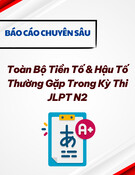
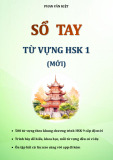
![Bài giảng Tiếng Trung Quốc du lịch khách sạn [Tập hợp]](https://cdn.tailieu.vn/images/document/thumbnail/2025/20251003/kimphuong1001/135x160/7291759464952.jpg)
![Đề thi Tiếng Trung 1 học kì 2 năm 2024-2025 có đáp án (Đề 2) - [Tuyển tập đề thi]](https://cdn.tailieu.vn/images/document/thumbnail/2025/20250920/kimphuong1001/135x160/76371758358928.jpg)

![Tài liệu Ngữ pháp HSK 2 [mới nhất]](https://cdn.tailieu.vn/images/document/thumbnail/2025/20250916/thanhhoa.lda@gmail.com/135x160/3241757994918.jpg)
